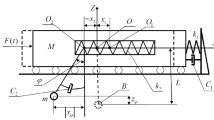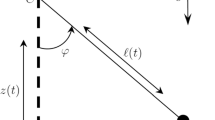Abstract
Introduction
The dynamical behavior of a suspension system that consisted of a slide block and a pendulum is investigated under the condition of small amplitudes. The effects of parameters on responses of the suspension system are discussed by calculating the rates of the change of the energy in the slide block and the pendulum, respectively.
Methods
The two frequencies of the suspension system are analytically derived by applying the averaging method. The energy method is employed to calculate the rates of the change of the energy of the suspension system.
Conclusion
The ratio between two frequencies nearly always is irrational, so the suspension system generally has quasi-periodic motions. Under the no damping condition, the direction of flow of the mechanical energy between the slide block and the pendulum depends on the initial phase difference between them. Furthermore, the exchange quantity of energy between the slide block and the pendulum increases with the stiffness of the slide block as well as the ratio between the masses of the pendulum and the slide block for the given length of the pendulum and initial conditions.
Practical implications
The research may contribute to the analysis and design of the pendulum-tuned mass damper.










Similar content being viewed by others
References
Zuo L (2009) Effective and robust vibration control using series multiple tunedmass dampers. J Vib Acoust Trans ASME 131:031003-1
Lin CC, Wang JF, Lien CH, Chiang HW, Lin CS (2010) Optimum design and experimental study of multiple tuned mass dampers with limited stroke. Earthq Eng Struct Dyn 39(14):1631–1651
Rao JS (2009) Engineering mechanical vibrations in 20th century. Adv Vib Eng 8(2):87–113
Eason RP, Sun C, Dick AJ, Nagarajaiah S (2013) Attenuation of a linear oscillator using a nonlinear and a semi-active tuned mass damper in series. J Sound Vib 332:154–166
Farshi B, Assadi A (2011) Development of a chaotic nonlinear tuned mass damper for optimal vibration response. Commun Nonlinear Sci Numer Simul 16:4514–4523
Chuang LL, Wu LY, Lien KH, Chen HH, Huang HH (2013) Optimal design of friction pendulum tuned mass damper with varying friction coefficient. Struct Control Health Monit 20(4):544–559
Sarkar A, Gudmestad OT (2013) Pendulum type liquid column damper (PLCD) for controlling vibrations of a structure: theoretical and experimental study. Eng Struct 49:221–233
Viet LD, Nghi NB (2014) On a nonlinear single-mass two-frequency pendulum tuned mass damper to reduce horizontal vibratiton. Eng Struct 81:175–180
Xu Z, Gong X, Chen X (2011) Development of a mechanical semi-active vibration absorber. Adv Vib Eng 10(3):229–238
Gowrisankar A, Nandi A, Neogy S, Das AS (2008) Vibration control of a beam using an eddy current damper with on-off control. Adv Vib Eng 7(4):343–351
Gerges RR, Vickery BJ (2005) Optimum design of pendulumtype tuned mass dampers. Struct Des Tall Spec Build 14(4):353–368
Roffel A, Narasimhan S, Haskett T (2013) Performance of pendulum tuned mass dampers in reducing the responses of flexible structures. J Struct Eng 139(12):04013019
Ashory MR, Najafi M, Jamshidi E (2012) Optimal design of a damped vibration absorber using genetic algorithm. Adv Vib Eng 11(1):47–58
Liu F, Chen LQ (2008) Complex modal analysis for vibration of damped continua. Adv Vib Eng 7(3):283–291
Edwardes EL (1977) The story of the pendulum clock. Sherratt, Altrincham
Leven RW, Koch BP (1981) Chaotic behaviour of a paramerically excited damped pendulum. Phys Lett A 86:71–74
Koch BP, Leven RW (1985) Subharmonic and homoclinic bifurcations in a parametrically forced pendulum. Phys D 16:1–13
Clifford MJ, Bishop SR (1995) Rotating perodic orbits of the parametrically excited pendulum. Phys Lett A 201:191–196
Garira W, Bishop SR (2003) Rotating solutions of the parametrically excited pendulum. J Sound Vib 263:233–239
Xu X, Wiercigroch M (2007) Approximate analytical solutions for oscillatroy and rotational motion of a parametric pendulum. Nonlinear Dyn 47:311–320
Lenci S, Rega G, Pavlovskaia E, Wiercigroch W (2008) Rotating solutions and stability of parametric pendulum by perturbation method. J Sound Vib 310:243–259
Zhen B, Xu J, Song ZG (2017) Influence of nonliearity on transition curves in a parametric pendulum system. Commun Nonlinear Sci Numer Simul 42:275–284
Li L, Ye HL (2003) Energy method for computing periodic solutions of strongly nonlinear autonomous systems with multi-degree-of-freedom. Nonlinear Dyn 31:23–47
Trueba JL, Baltanas JP, Sanjuan MAF (2003) A generalized perturbed pendulum. Chaos Solitons Fractals 15:911–924
Clifford MJ, Bishop SR (1996) The use of manifold tangencies to predict orbits, bifurcations and estimate escape in driven systems. Chaos Solitons Fractals 7:1537–1553
Wang DG, Zhao CY, Yao HL, Wen BC (2012) Vibration synchronization of a vibrating system driven by two motors. Adv Vib Eng 11(1):59–73
Huang Y, Meng FW (2009) Oscillation criteria for forced second-order nonlinear differential equations with damping. J Comput Appl Math 224:339–345
Zheng Z, Wang X, Han H (2009) Oscillation criteria for forced second order differential equations with mixed nonlinearities. Appl Math Lett 22:1096–1101
Liu LH, Bai YZ (2009) New oscillation criteria for second-order nonlinear neutral delay differential equations. J Comput Appl Math 231:657–663
Shao J, Meng FW, Pang XQ (2012) Generalized variational oscillation principles for second-order differential equations with mixed-nonlinearities. Discrete Dyn Nat Soc Article ID 539213
Meng FW, Huang Y (2011) Interval oscillation criteria for a forced second-order nonlinear differential equations with damping. Appl Math Comput 218:1857–1861
Acknowledgements
This work was supported by the National Natural Science Foundation of China (Grant nos.11472160, 11672185).
Author information
Authors and Affiliations
Corresponding author
Additional information
Publisher's Note
Springer Nature remains neutral with regard to jurisdictional claims in published maps and institutional affiliations.
Rights and permissions
About this article
Cite this article
Wen, R., Li, T.T. & Zhen, B. Quasi-periodic Motions of a Pendulum with Vibrating Suspension Point. J. Vib. Eng. Technol. 7, 519–532 (2019). https://doi.org/10.1007/s42417-019-00175-4
Received:
Accepted:
Published:
Issue Date:
DOI: https://doi.org/10.1007/s42417-019-00175-4




